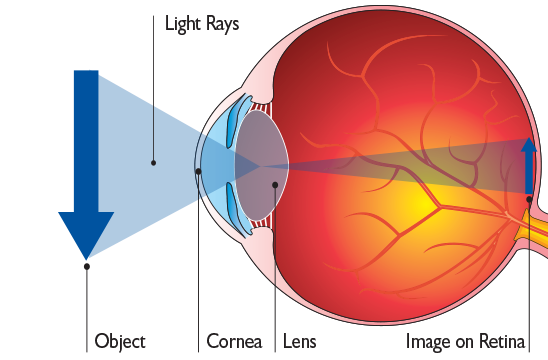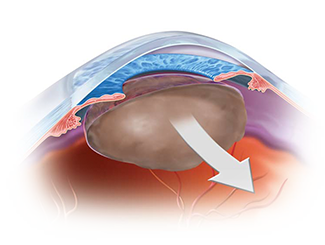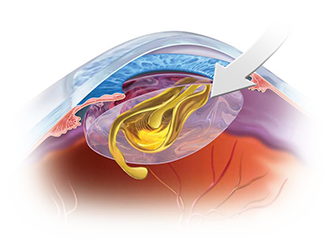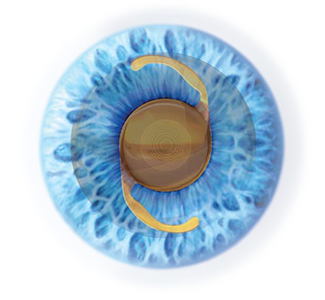Custom Laser Cataract Eye Surgery with LenSx® Procedure
It has been called a bold leap forward. Performing cataract surgery with a laser has been the dream of eye surgeons for many years. And finally, the FDA has approved laser cataract surgery as safe and effective, and it’s here now at the Rand Eye Institute. LenSx custom laser cataract surgery represents one of the great surgical advances of our time.
LenSx laser technology harnesses the power and precision of the femtosecond laser for the cataract surgery. It works by using optical coherence tomography (OCT) with near infrared light, to produce real-time digital analysis coupled with computer driven femtosecond laser application. Because the OCT is continuous in real-time, all of the eye structures are continuously displayed accurately in 3-dimensional (3D) digital representation. Providing 3D mapping, LenSx enables exact spacial placement within the eye for precise laser application.
“The accuracy of the LenSx system is a marvel of technology; there has never been anything like this before. One look at the video of this laser cataract procedure leaves even the most experienced eye doctor amazed at how far we have come.”
William J. Rand, MD
Medical Director
Rand Eye Institute
Refractive Cataract Surgery
Recapture the Vision of Your Youth®
Refractive Cataract Surgery offers you a whole new world of improved vision beyond what basic cataract surgery can provide. It’s an additional level of care that brings together the latest technological innovations in eye surgery to help obtain the best vision your eyes are capable of seeing.
Is your vision blurry or foggy?
Do colors appear dull or muted?
Are your glasses no longer working?
Does sunlight or other light seem overly bright or glaring?
Do you have decreased night vision or see halos around lights?
If you experience one or more of these symptoms, you may have cataracts, a clouding of your eye’s natural lens that affects many of us as we age. Cataracts are the leading cause of visual loss in adults 55 and over.
Fortunately, we live in a time when correcting cataracts is easily accessible and the results can be extraordinary. With today’s advances, some patients enjoy the best vision of their lives.
How We See
Our eyes work just like a camera. When we look at an object, light rays reflect off that object and enter the eye through the cornea. The lens behind the cornea focuses the rays onto the retina, which, in turn, converts the rays into electrical impulses that travel through the optic nerve to the brain. The brain perceives the electrical impulses as an image.
Seeing depends on this entire chain of events. But seeing clear, focused images depends largely on having a crystal clear lens.
Common Vision Problems
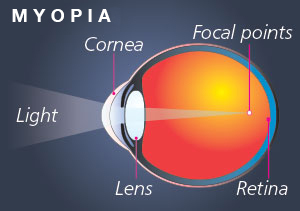
Myopia (Nearsightedness)
People who are nearsighted can see up close, but have difficulty seeing objects at a distance. The term nearsighted is used because generally speaking, one can see clearly only at near. Myopia is typically caused by an eye that is too long or has too much focusing power, which causes light to focus in front of the retina instead of on the retina itself.
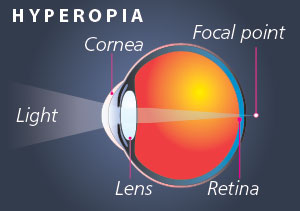
Hyperopia (Farsightedness)
Farsighted people can see objects at a distance, but have difficulty seeing up close. Hyperopia (farsightedness) is usually caused by an eye that is either too short or has a weaker focusing power, which causes light to focus beyond the retina instead of on the retina itself.
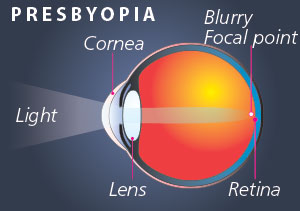
Presbyopia
Presbyopia is an age-related condition that blurs near vision. It’s caused by a gradual loss of flexibility in the eye’s natural lens and surrounding muscles. Presbyopia, may require the use of bifocal or “progressive” lenses to see clearly both near and far.
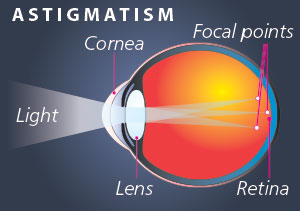
Astigmatism
The normal cornea has a symmetrical curvature. In astigmatism case, the surface of the cornea is more elliptical than round, with both flatter and steeper curves. This common irregularity, called “corneal astigmatism,” causes blurred or distorted vision. This occurs when the light rays are focused at different spots instead of being focused sharply at one spot on the retina.
Presbyopia, myopia, hyperopia, or astigmatism requires the use of bifocal or “progressive” lenses to see clearly both near and far. The important thing to remember is that cataract surgery at the Rand Eye Institute can often correct one or more of these at the same time. This means it may be possible for you to gain clear vision with little or no need for glasses or contact lenses.
Cataracts:
a natural part of aging
Cataracts are the leading cause of visual loss in adults 55 and over. A cataract is a clouding of the natural lens inside your eye. This lens, located behind the iris, works just like the lens of a camera — focusing light images on the retina, which sends images to the brain. The human lens can become so clouded it prevents light and images from reaching the retina.
“I knew there was something wrong with my eyes when I went up to the mall and everybody’s face was fuzzy. It frightened me a little so I turned around, went home, and called the doctor.”
Lois, PA
A cataract can be the reason sharp objects become blurred, bright colors become dull, or seeing at night is more difficult. It may also be why reading glasses or bifocals that used to help you no longer seem to be effective. Vision with cataracts has been described as seeing life through old, cloudy film.
But a cataract is not a “film” over the eye, and neither diet nor lasers will make it go away. Nor can it be prevented. Eye injury, certain diseases, or even some medications can cause clouding, but the majority of cataracts are simply a result of the natural aging process. The best way to treat a cataract is with surgery that removes the old, clouded lens and replaces it with a new, artificial one to restore your vision and, in many ways, significantly improve your quality of life.
Normal Vision

The same scene viewed through cataract

Cataract surgery:
Clarity in the blink of an eye
Modern cataract surgery at the Rand Eye Institute is a simple, painless outpatient procedure to regain vision. Cataract removal is one of the safest and most effective surgical procedures. In fact, more than 3 million* cataract surgeries are performed each year in the United States. The operation entails making a tiny incision in the eye and inserting an instrument about the size of a pen tip to break up and remove the cloudy lens. Once the cloudy lens is removed, a cataract replacement lens or “IOL” is inserted through the same tiny incision and set into its permanent position.
“I have a grandson who is one year old, I want to be able to read to him, and do things with him, without running around the house looking for a pair of glasses, now I can do anything with him.
I love to knit and sew and now I can thread a needle without having big glasses on. Now I can knit and take out knots, it’s just a whole new way of life, it’s fantastic just being able to see.”
— Leslie, FL
What to expect
before and after surgery
Most people are surprised to find out just how easy and pain-free cataract surgery is. It usually takes 20 to 30 minutes or less and most patients are back to their normal activities the very next day. The following facts will help you prepare for surgery:
- An anesthetic will be given to numb the nerves in and/or around your eye. We almost never use injectable local anesthesia around the eye.
- Before and/or after surgery your doctor may prescribe eye drops to help prevent infection and reduce swelling.
- Most patients have improved vision soon after surgery, but your sight may continue to improve for several days or weeks.
Cataract Removal
After making a small incision in your eye,your surgeon will insert an instrument about the size of a pen tip to remove thecataract, using either high-frequency soundwaves to gently break up the cloudylens (phacoemulsification), or pulses offluid to wash it away (liquefaction).
Lens Insertion
The cataract-affected natural crystallinelens is replaced with an artificial intraocularlens (IOL). IOLs are typically made of aflexible material, allowing your surgeon tofold and insert the IOL through a very smallincision. Once inserted, the IOL opens, andits haptics, or “arms,” unfold to keep it in place.
Vision Restored
Once the cataract is removed, and theIOL is in proper position, light can onceagain travel unimpeded to the back ofyour eye. Recovery after cataract surgeryis generally quick and usually occurswithin only a few days.
What is an IOL?
An intraocular lens (IOL) is an artificial lens that’s implanted during cataract surgery. The good news is that you’ve encountered cataracts at a time when intraocular lens technology has taken great leaps of progress.
Traditionally, basic monofocal IOLs were used for cataract surgery. This type of lens is very effective at restoring functional distance vision. However, people still need glasses to correct for near vision, and glasses or additional surgery were needed to correct any existing astigmatism.
Significant advances with new-generation lenses can allow you to see well at all distances virtually without the help of glasses, bifocals, or reading glasses. Following are the three primary types of lenses currently available. Each is designed to restore vision in a different way:
Monofocal lenses
Have one point of focus and can usually give you clear distance vision. While distance vision is improved, most patients still need to wear glasses for certain tasks, such as reading or working at a computer.
Multifocal lenses
Are designed to replace cataracts and correct presbyopia at the same time. Their goal is to give you a full range of clear vision, near to far, and everywhere in between.
Accommodating lenses
As the name implies, an accommodating lens “flexes” or “accommodates” using the eyes natural muscles to focus on subjects at various distances, delivering a fuller, more natural range of vision.
Astigmatism-correcting lenses
Are for patients with existing corneal astigmatism. Similar to monofocal lenses, these lenses usually give patients quality distance vision with less dependence on glasses. Most patients will still need to wear glasses for tasks such as reading or working at a computer.
The correct lens for you will depend on your eyes and your desire to be glasses-free. Your doctor will review your options and explain what you can expect from each one.
Cataracts can dramatically affect everything you see and do. But they don’t have to. With a simple procedure, you can lift the fog and get back to seeing what you love. Colors can appear rich and vibrant, and everything you look at can be in clear focus.
“It was so easy. It was just a series of eye drops maybe three days before and on the day of surgery. I was in and out in two hours.”
Richard, FL
Rand-Stein Analgesia Protocol
One major innovation in cataract surgery is the Rand-Stein Analgesia Protocol (as published in the May 2000 issue of Ophthalmology). Developed at the Rand Eye Institute, the Rand-Stein Analgesia Protocol eliminates the need for local anesthetic injections and reduces the risk of damage that these injections could cause to the eye. All medications used in the protocol are FDA-approved, and comes as an important advancement in cataract surgery, which has been studied by thousands of eye surgeons worldwide.
Rand Surgical Pavillion
The Rand Surgical Pavillion, located on the first floor of the Rand Eye Institute, is a state-of-the-art surgical center that is inspected and licensed by the State of Florida Agency for Health Care Administration (AHCA) and regulated by agencies of the State and Federal government. The Joint Commission, the nation’s oldest and largest healthcare accrediting agency, also accredits the Rand Surgical Pavillion.
Strict adherence to government licensure requirements and the Joint Commission accreditation standards assures that our staff will always have the ability to properly manage any critical care problem with the highest level of care.
A Tradition of Excellence
The Rand Eye Institute has a history of accomplishment spanning more than a generation. We maintain an ongoing tradition of excellence and a firm commitment to quality care and education.
“I went in for a new pair of glasses and instead got a new pair of eyes.”
Betty Ann, TN
Q&A
When is the best time to treat cataracts?
Many people believe cataracts have to be “ripe” before they can be removed. This is no longer true. Today, cataract surgery is a routine procedure that can be performed as soon as your vision interferes with the quality of your life.
What happens if cataracts go untreated?
Over time, the clouded areas of your lens can become larger and denser, causing your sight to become worse. This could take anywhere from a few months to many years. Eventually, your entire lens can cloud over and cause blindness.
How do I know which lens implant is right for me?
No single lens works best for everyone, and only your ophthalmologist can determine the most appropriate option for you. Overall, patients who chose the multifocal over the monofocal intraocular lens have expressed greater satisfaction with the increased quality of living. Passengers could become drivers again, and golfers could keep their eye on the ball while enjoying the surrounding scenery.
Can cataracts come back?
Once a cataract has been removed it cannot return. However, over time, patients may complain that their vision has once again become cloudy. This condition is known as a secondary cataract. It can be easily and rapidly treated by a simple laser procedure performed in the office.
Who performs cataract surgery?
Only ophthalmologists who have had special training in eye surgery can perform cataract surgery.
How successful is cataract surgery?
Cataract surgery has an overall success rate of 98% or greater. Continuous innovations in techniques and instruments have made the procedure safer than ever.
Learn More About Refractive Cataract Surgery Options We Offer – Click Here
IMPORTANT SAFETY INFORMATION
All surgical procedures and medical devices have risks. At the Rand Eye Institute, the risks and benefits of surgical procedures and medical devices are discussed in detail prior to scheduling for surgery. A comprehensive discussion with your surgeon will enable you to make an informed decision. We screen all patients prior to all surgeries and do extensive pre-surgical testing to eliminate from consideration those who may not be a suitable candidate for a procedure. It is the goal of our organization to safely obtain the best results for those who are appropriate candidates for a given procedure.

